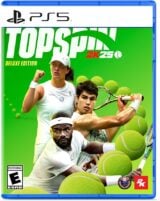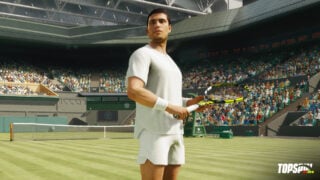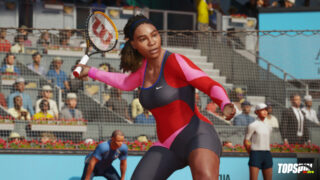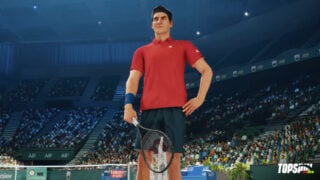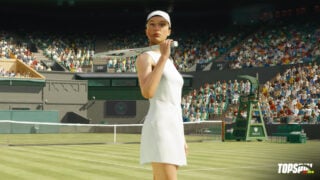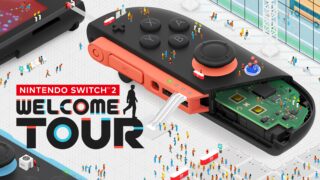TopSpin 2K25 is a hugely satisfying return for an ace tennis series
It’s been 13 years since the last entry, but 2K has brought it back with a bang
- Game director
- Rémi Ercolani
- Key Credits
- Viliam Korbel (Lead producer), Adam Kruták (Art director)

Although its relationship with video games goes all the way back to Pong, tennis has seemingly always been a tricky sport to properly nail in digital form.
While there have clearly been successes over the years – the Virtua Tennis and Mario Tennis series being the obvious examples – the history of the medium is littered with attempts that struggled to recreate the feel of playing tennis.
One series that pulled it off with aplomb was 2K’s TopSpin. While its last entry—2011’s Xbox 360 and PS3 title TopSpin 4—was met with widespread critical acclaim, it was the last we’d see of the franchise. That finally changes now, because after a 13-year gap, TopSpin is back. While it has a few performance and progression issues, when it comes to the actual gameplay on the court, it’s a spectacular return to form.
The game revolves around its new stroke mechanic, which brings up an accuracy gauge similar to the one in the NBA 2K series (but is thankfully more forgiving). While the face buttons perform different types of strokes, players can give themselves more control over them with a combination of timing and button press duration.
Tapping the button performs a control shot, which is lacking in power but gives you a better chance of hitting the ball close to the lines. Holding it down until a power gauge fills gives you a power shot, which reduces the angles you can hit but adds plenty of extra oomph to the hit. Then there’s a middle ground where you can hold the button for a little while.
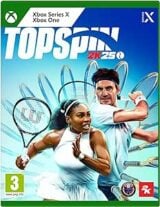
This combines with the accuracy gauge to determine how effective the hit is. The gauge moves at different speeds depending on the complexity of the stroke, so it’s a great system because it’s easy to learn quite quickly but certainly not to the extent that you can hit perfect shots every time without fail.
It all works very well and makes logical sense too. If you’re standing behind the baseline, the gauge moves slowly because you usually have plenty of time to prepare your stroke, but when you have to hit an awkward shot under pressure, the gauge will fill quicker, meaning your chances of hitting it accurately are reduced in a realistic manner.
The stroke mechanic is taught to the player in a tutorial mode partly narrated by John McEnroe, who frankly sounds like he’s never encountered a microphone before. Halfway through the lessons, he disappears and is replaced by a nameless lady narrator instead, and she does a better job.
It’s all irrelevant, though, because the important thing is that it does a great job of teaching players how to hit the ball properly, and once the tutorial is done it takes around 30-60 minutes to get a proper feel for it, after which it all clicks and its value as a flexible control system becomes clear.
We can find no real faults in the gameplay, then, but that’s not to say that TopSpin 2K25 doesn’t have issues elsewhere. For starters, the character models look somewhat off. While it’s clear who most of them are supposed to be, and while a couple like Serena Williams and Roger Federer look really accurate, the majority are a bit off, which is especially disappointing for a publisher like 2K Sports which typically specialises in startlingly realistic renditions of NBA and WWE athletes.
“The game revolves around its new stroke mechanic, which brings up an accuracy gauge similar to the one in the NBA 2K series (but is thankfully more forgiving).”
Other characters, like the crowd, the ball boys / girls and the staff who present trophies, look rather outdated. We’re not the types to indulge in hyperbolic “this looks like a PS2 game” nonsense, but the NPCs here certainly wouldn’t have looked out of place a generation or two ago. From a distance the crowd looks impressive, but the game’s tendency to cut to individual crowd members between points and show them up-close can be distracting.
At least the roster itself is strong at launch, with 25 pros available from tennis’s past and present. Modern players like Raducanu, Osaka, Gauff, Medvedev and Alcaraz are joined by legends like Sampras, McEnroe, Sharapova, Graf and the recently retired Federer and Williams.
2K says more playable pros will be added after launch, and will all be free updates, so it’ll be interesting to see who’s on the way. As long as Cliff Richard isn’t among them, we’ll be happy.
The game’s main single-player mode is MyCareer, where you work your way through a calendar consisting of training events, special events and tournaments. Special events give you drills and match modifiers to mix things up a bit, and reward with XP, currency and other unlockables such as cosmetic items and courts.

It’s a reasonable enough mode, but it does feel a little lacking in character, particularly given that 2K is an industry leader when it comes to career modes in sports games. The NBA 2K series has been delivering annual story modes for years – the Journey story mode in FIFA 17, 18 and 19 was clearly inspired by them – and the WWE 2K games have started to follow suit.
We’d have loved a proper story mode where your created character interacts with other pros and fictional characters on their way up the rankings. Instead, the only plot of sorts as you progress through the leaderboards is a series of fake podcasts which are written well enough (you can re-read the transcripts later) but are performed in an unconvincing manner which clearly makes them sound like they’re being read from a script.
MyCareer aside, the game puts forth its obligatory live service content in the shape of the Centre Court Pass, a series of six seasons which each come with free and premium tiers of unlockables, with the typical daily and weekly tasks you’d expect from such a structure.
“It’s just that the cosmetics on offer are so boring we really can’t see many players forking out the equivalent of £5 for an item literally just called ‘White Dress’.”
Season 1 is based on the Roland Garros French Open and contains 50 tiers, consisting of clothing items for your custom character, new animations, VC currency, online mottos / titles and such. It isn’t until you get near the end that you start to get the cooler stuff, from more elaborate cosmetics to new skins for some of the pros, including a brilliant 90s version of Andre Agassi that replaces his current bald head with his trademark mullet.
Each season is set to last 8-10 weeks but, in a welcome touch – and something that had previously been implemented in Lego 2K Drive – 2K says existing seasons won’t expire when a new one launches. This means players can continue to unlock rewards in older seasons at their own pace, instead of feeling they have to play the game every day to get through all the tiers within two months.
Less generous is the game’s Pro Shop, where new cosmetic items can be bought for your custom player. This is where the old 2K monetisation comes into play, and it’s so overpriced it’s just bewildering that anyone would bother with it.
At the time of writing, the shop includes a special bundle containing a pair of green shorts, red wristbands, a new racquet, a white polo shirt and a pair of black and green shoes. It’s all pretty unremarkable stuff but it costs 1880 VC – a pack of 500 VC costs £4.49, so you’re talking around £18 to buy it, which is comical for such generic equipment.
VC can be earned through gameplay, but naturally, the rate at which you earn it is slow enough to make the player feel the need to spend real money for more. It’s just that the cosmetics on offer are so boring we really can’t see many players forking out the equivalent of £5 for an item literally just called ‘White Dress’.
The typical 2K hijinks aside, what’s on offer here so far is enough to make us recommend TopSpin 2K25, because where it matters – on the court – it’s easily one of the best tennis games we’ve ever played. The only players we’d urge a bit of restraint to are those expecting to mainly play the game online, because given the nature of the review process our time spent on these modes has been limited.
The matches we played pre-launch featured only slight lag, but 2K games has a habit of sometimes being awful online – WWE 2K24’s MyFaction Ranked matches are still practically unplayable – so if online play is your priority, it might be worth holding fire until the game’s been out for a week or two and see if the online community is happy enough with performance and connection stability.

It should also be pointed out that, bizarrely, you can’t currently play an online match against someone on your friends list, but 2K says this will be coming in an update “before the end of May”.
For everyone else, whether you’re planning to mainly play through the (admittedly rather dry) career mode, work your way through the Season Passes or play friends locally in 2-4 player matches, TopSpin 2K25 is fantastically satisfying to play, and a true comeback for tennis video games.
TopSpin 2K25 is the best 'serious' tennis game we've played since, frankly, the last one was released 13 years ago. Its characters look a bit off, its career mode is dry and the typical 2K microtransaction nonsense is in there (to a less intrusive extent than usual), but when it comes to the gameplay on the court it's far superior to anything else out there.
- One of the best stroke mechanics we've ever seen in a tennis game
- A healthy selection of pros, with more to come
- Season Passes can be played at your own pace
- Huge variety of licensed and fictional courts
- Character models can look a bit off and NPCs look outdated
- Career mode isn't as engaging as in other 2K Sports games






